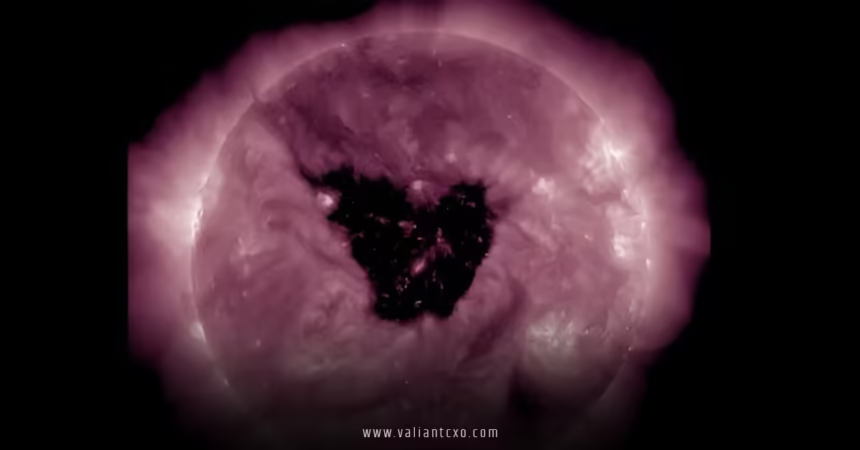How butterfly shaped hole on the sun affects Earth? That’s the question buzzing around space enthusiasts right now, especially after NASA’s stunning capture of this cosmic oddity just a few days ago. Picture this: a massive, ethereal void on our star’s surface, resembling the delicate wings of a butterfly, unleashing streams of charged particles hurtling toward our planet. It’s not some sci-fi plot—it’s real space weather drama unfolding as we speak. In this article, we’ll dive deep into what this phenomenon means for us down here on Earth, from dazzling light shows in the sky to sneaky tech glitches. Stick with me; by the end, you’ll see why keeping an eye on the Sun isn’t just for astronomers anymore.
What Is the Butterfly Shaped Hole on the Sun?
Let’s start at the beginning. You might be wondering, what on Earth—or rather, what on the Sun—is this butterfly shaped hole? It’s not a literal hole punched through our star, thank goodness. Instead, it’s a coronal hole, a fascinating feature in the Sun’s outer atmosphere, known as the corona. These holes appear as dark patches because they’re cooler and less dense than the surrounding plasma, which glows brightly in extreme ultraviolet light.
This particular butterfly shaped hole popped up on September 11, 2025, as captured by NASA’s Solar Dynamics Observatory. Spanning an whopping 500,000 kilometers across— that’s about 23 times the width of Earth—it’s a behemoth. Its symmetrical, wing-like form caught everyone’s attention, making it look like a celestial insect ready to take flight. But why does how butterfly shaped hole on the sun affects Earth matter so much? Because from this void, solar wind blasts out at super speeds, potentially stirring up our planet’s magnetic field like a cosmic blender.
The Science Behind Coronal Holes
Ever heard of the Sun’s magnetic field? It’s like an invisible force field generated by the churning plasma inside our star. In most areas, these magnetic loops are closed, trapping hot particles and creating that fiery corona we see during eclipses. But in coronal holes, the field lines open up, allowing particles to escape freely into space. This escape route lets solar wind—a constant stream of charged particles—accelerate to over 1.8 million miles per hour.
These holes aren’t new; they’ve been observed since the 1970s with satellites like Skylab. But this butterfly one? It’s positioned perfectly, facing Earth, so its high-speed solar wind is barreling our way. Imagine the Sun as a pressure cooker with a faulty valve—that’s the coronal hole, releasing pent-up energy that could ripple all the way to us.
Why the Butterfly Shape Stands Out
What makes this hole so visually striking? The shape comes from the complex twisting of the Sun’s magnetic fields. As the star rotates, these fields can align in symmetrical patterns, forming what looks like wings spread across the solar surface. It’s almost poetic, right? A butterfly emerging from the Sun’s fiery chaos. Scientists at NOAA’s Space Weather Prediction Center are monitoring it closely because its central location means the solar wind it ejects will hit Earth head-on, amplifying how butterfly shaped hole on the sun affects Earth in unpredictable ways.
How Butterfly Shaped Hole on the Sun Affects Earth: The Solar Wind Connection
Now, let’s get to the heart of it—how does this distant solar feature actually touch our lives? The key player is solar wind, that river of protons and electrons flowing from the Sun. From a coronal hole like this butterfly-shaped one, the wind speeds up dramatically, creating what’s called a high-speed stream (HSS). When it reaches Earth after a three-to-four-day journey, it slams into our magnetosphere—the protective bubble around our planet.
Think of it like a garden hose on full blast hitting a sail. The magnetosphere compresses on the sunward side, and the energy builds up. This interaction can trigger what’s known as a co-rotating interaction region (CIR), where fast wind catches up to slower wind ahead of it, forming compression waves. For this event, forecasts suggest the wind arriving around September 14, 2025, could spark minor to moderate geomagnetic storms. So, how butterfly shaped hole on the sun affects Earth starts with this invisible barrage, but the ripples? They’re anything but subtle.
The Path from Sun to Earth
Solar wind isn’t uniform; from coronal holes, it’s faster and denser at the edges. This butterfly hole’s position near the solar equator means its stream is aimed right at us. Traveling at speeds up to 800 km/s, it covers the 150 million kilometers to Earth in about 48-72 hours. Along the way, it carries the Sun’s magnetic field, which can reconnect with Earth’s, opening gateways for particles to pour in.
Rhetorical question time: Have you ever felt a storm brewing from miles away? That’s similar—space weather builds tension before the show. And with the autumnal equinox approaching on September 22, the Russell-McPherron effect kicks in, tilting Earth’s magnetic field to better “catch” the incoming wind, potentially intensifying the effects.
Geomagnetic Storms: The Main Event Triggered by How Butterfly Shaped Hole on the Sun Affects Earth
Geomagnetic storms are the drama queens of space weather, and this butterfly hole could direct the spotlight. Rated on a G-scale from 1 to 5, we’re looking at G1 (minor) to G2 (moderate) for September 13-15, 2025. These storms happen when solar wind disturbs the magnetosphere, causing it to ring like a bell.
Breaking Down Geomagnetic Storms
What causes them? The incoming solar wind from the hole interacts with Earth’s field, inducing currents and vibrations. It’s like shaking a snow globe—the particles inside (auroral ones) get excited. For mild storms like this, the impacts are mostly benign, but they remind us of our tech-dependent world. Stronger storms, though rare from coronal holes alone, can pack a punch, but this one’s more of a gentle nudge.
Auroras: The Beautiful Side Effect
Ah, the auroras! If you’re in the northern U.S., Canada, or Scandinavia, you might catch a glimpse this weekend. These storms supercharge the auroral oval, pushing the lights equatorward. Imagine rivers of green and purple dancing across the sky—caused by solar particles colliding with oxygen and nitrogen in our atmosphere, releasing photons like a natural fireworks show.
From how butterfly shaped hole on the sun affects Earth, we get this gift: enhanced auroras visible even from New York or Idaho during a G2 event. I’ve always found it mesmerizing how something so far away can paint our night sky. If you’re planning a stargazing trip, check apps or forecasts—timing is everything.
Technological Ripples: How Butterfly Shaped Hole on the Sun Affects Earth’s Infrastructure
Not all effects are pretty lights. Geomagnetic storms, even mild ones, can whisper warnings to our tech. Satellites in low Earth orbit feel the heat first—extra drag from an expanded atmosphere can nudge them off course. GPS signals? They might jitter, affecting everything from your car’s navigation to airline routes.
Power grids are another worry. Induced currents from the storm can overload transformers, like what happened in the 1989 Quebec blackout from a bigger event. For this butterfly hole, risks are low, but it’s a reminder: how butterfly shaped hole on the sun affects Earth includes these subtle threats. Radio communications, especially HF bands, could black out briefly, and astronauts on the ISS might hunker down from radiation spikes.
Satellite and Communication Disruptions
Picture your smartphone losing signal mid-call—that’s the mild version. High-frequency radios used by pilots and ships rely on the ionosphere, which swells during storms, scrambling signals. A faint coronal mass ejection (CME) tagged along with this hole, potentially adding a glancing blow on September 14, upping the ante slightly.
Power and Everyday Life
Most folks won’t notice, but utilities monitor closely. In extreme cases, blackouts cascade, but here? Probably just a blip. Still, it’s why agencies like NOAA issue alerts—preparation turns potential chaos into a managed event.
Historical Context: Past Butterfly Shaped Holes and Their Lessons
This isn’t the first butterfly-like coronal hole. Back in 2023, a similar one graced the Sun, sparking auroras worldwide. Those events taught us how persistent holes—lasting weeks—can recurrently hit Earth every 27 days as the Sun rotates.
From history, we know coronal holes peak during solar minimum, but we’re in solar maximum now (Solar Cycle 25), so these features mix with flares and CMEs for lively space weather. How butterfly shaped hole on the sun affects Earth has evolved our understanding; early missions like SOHO paved the way for today’s precise predictions.
Lessons from Previous Events
Remember the 2003 Halloween storms? Coronal holes contributed to massive disruptions. Today’s tech, like AI-driven forecasts, helps mitigate. It’s empowering— we can’t control the Sun, but we can adapt.
Monitoring and Predicting: Staying Ahead of How Butterfly Shaped Hole on the Sun Affects Earth
How do we know what’s coming? Satellites like SDO and GOES keep watch, imaging the Sun in real-time. Models simulate solar wind propagation, giving 1-3 day warnings. Apps from space weather sites let you track aurora probabilities.
As of September 15, 2025, the wind has likely arrived, and early reports suggest auroras lit up northern skies last night. Uncertainty lingers—space weather is probabilistic—but that’s the thrill.
Tools and Resources for Enthusiasts
Grab your phone: NOAA’s aurora forecast or Space Weather Live apps are gold. Join communities on Reddit or X for live updates. It’s like having a front-row seat to how butterfly shaped hole on the sun affects Earth unfold.
Broader Implications: Climate and Long-Term Effects
Does this tie into climate change? Not directly—solar wind doesn’t warm the planet. But geomagnetic storms influence the upper atmosphere, subtly affecting satellite drag and ozone. Long-term, understanding these helps protect assets in space, crucial as we expand to the Moon and Mars.
How butterfly shaped hole on the sun affects Earth underscores our interconnected cosmos. It’s a humbling reminder that the Sun isn’t just a light bulb; it’s a dynamic force shaping our world.
In wrapping up, how butterfly shaped hole on the sun affects Earth boils down to a mix of wonder and caution. This September 2025 event, with its stunning butterfly form, promises auroras that could wow skywatchers while nudging our tech to stay resilient. From geomagnetic storms sparking natural light displays to potential hiccups in satellites and grids, it’s a snapshot of space weather’s power. We’ve got the tools to monitor and mitigate, turning potential disruptions into opportunities for awe. So, next time you gaze at the stars, remember: the Sun’s quirks reach farther than you think. Head outside tonight—who knows what colors await?
FAQs
What causes the butterfly shaped hole on the Sun?
The butterfly shaped hole is a coronal hole formed by open magnetic field lines in the Sun’s corona, allowing cooler plasma to create a dark, wing-like void. How butterfly shaped hole on the sun affects Earth depends on the solar wind it releases.
How soon does solar wind from the butterfly shaped hole reach Earth?
Solar wind from this hole, observed on September 11, 2025, travels at high speeds and typically arrives at Earth in 2-4 days, potentially impacting us around September 14-15.
Can how butterfly shaped hole on the sun affects Earth cause power outages?
Yes, through induced currents in geomagnetic storms, but for this mild event, outages are unlikely; stronger storms pose bigger risks to grids.
Where can I see auroras from how butterfly shaped hole on the sun affects Earth?
Northern latitudes like Alaska, Canada, and Scandinavia are prime spots; a G2 storm might push visibility south to the U.S. northern states.
Is how butterfly shaped hole on the sun affects Earth dangerous for humans?
No direct harm to people on the ground, thanks to Earth’s atmosphere, but it can increase radiation for astronauts and disrupt tech.
For More Updates !! : valiantcxo.com


